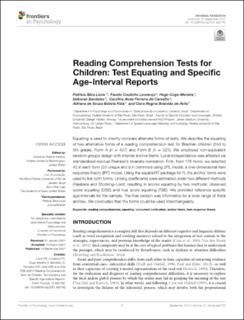| dc.contributor.author | Lúcio, Patrícia Silva | |
| dc.contributor.author | Lourenço, Fausto Coutinho | |
| dc.contributor.author | Cogo-Moreira, Hugo | |
| dc.contributor.author | Bandalos, Deborah | |
| dc.contributor.author | Carvalho, Carolina Alves Ferreira de | |
| dc.contributor.author | Kida, Adriana de Souza Batista | |
| dc.contributor.author | Ávila, Clara Regina Brandão de | |
| dc.date.accessioned | 2022-01-21T13:36:34Z | |
| dc.date.available | 2022-01-21T13:36:34Z | |
| dc.date.created | 2021-12-07T14:55:12Z | |
| dc.date.issued | 2021 | |
| dc.identifier.citation | Frontiers in Psychology. 2021, 12, Artikkel 662192. | en_US |
| dc.identifier.issn | 1664-1078 | |
| dc.identifier.uri | https://hdl.handle.net/11250/2838741 | |
| dc.description.abstract | Equating is used to directly compare alternate forms of tests. We describe the equating of two alternative forms of a reading comprehension test for Brazilian children (2nd to 5th grade), Form A (n = 427) and Form B (n = 321). We employed non-equivalent random groups design with internal anchor items. Local independence was attested via standardized residual Pearson’s bivariate correlation. First, from 176 items, we selected 42 in each form (33 unique and 9 in common) using 2PL model, a one-dimensional item response theory (IRT) model. Using the equateIRT package for R, the anchor items were used to link both forms. Linking coefficients were estimated under two different methods (Haebara and Stocking–Lord), resulting in scores equating by two methods: observed score equating (OSE) and true score equating (TSE). We provided reference-specific age-intervals for the sample. The final version was informative for a wide range of theta abilities. We concluded that the forms could be used interchangeably. | en_US |
| dc.language.iso | eng | en_US |
| dc.publisher | Frontiers | en_US |
| dc.rights | Navngivelse 4.0 Internasjonal | * |
| dc.rights.uri | http://creativecommons.org/licenses/by/4.0/deed.no | * |
| dc.subject | reading comprehension | en_US |
| dc.subject | equating | en_US |
| dc.subject | concurrent calibration | en_US |
| dc.subject | anchor items | en_US |
| dc.subject | item response theory | en_US |
| dc.title | Reading Comprehension Tests for Children: Test Equating and Specific Age-Interval Reports | en_US |
| dc.type | Peer reviewed | en_US |
| dc.type | Journal article | en_US |
| dc.description.version | publishedVersion | en_US |
| dc.rights.holder | © 2021 Lúcio, Lourenço, Cogo-Moreira, Bandalos, Carvalho, Kida and Ávila. | en_US |
| dc.subject.nsi | VDP::Samfunnsvitenskap: 200::Pedagogiske fag: 280::Fagdidaktikk: 283 | en_US |
| dc.source.volume | 12 | en_US |
| dc.source.journal | Frontiers in Psychology | en_US |
| dc.identifier.doi | 10.3389/fpsyg.2021.662192 | |
| dc.identifier.cristin | 1965701 | |
| dc.source.articlenumber | 662192 | en_US |
| cristin.ispublished | true | |
| cristin.fulltext | original | |
| cristin.qualitycode | 1 | |

